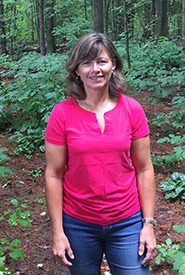Earth Day 2018: Buddies, boundaries and nearby nature
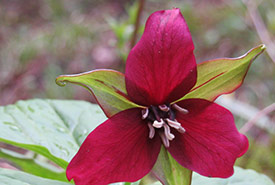
Red trillium (Photo by Sherry Nigro)
Earth Day is a good time to think about the future.
How do we ensure our children grow up healthy and happy? Research suggests that the answer is right outside our back door: help them connect with nature.
Benefits of time in nature
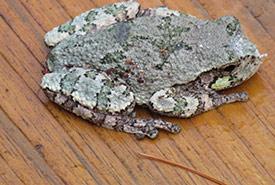
Gray treefrog (Photo by Sherry Nigro)
Spending time in natural settings, especially engaging in free play, is linked with improved physical health1. Children are more physically active, develop stronger motor skills, sleep better and are less at risk for nearsightedness. This reduces their risk of obesity, chronic diseases, such as hypertension and diabetes, and injury2.
Their mental health also benefits from time in nature. Children show improved cognitive function, better focus and reduced stress3. They also build stronger social relationships, experience more positive self-esteem and demonstrate better problem solving. And to top it off, Canadian researchers Elizabeth Nisbet and John M. Zelenski have reported that there is substantial evidence that links access to nature with increased well-being and happiness4.
Making it happen
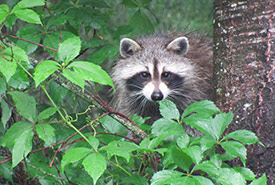
Raccoon (Photo by Sherry Nigro)
Before you protest about the dangers of unsupervised play, such as stranger danger, injury, rabid animals, ultraviolet radiation and vector-borne diseases, give yourself a reality check. The actual risks are pretty small. For example, according to the 2015 ParticipACTION Report Card, “The Biggest Risk is Keeping Kids Indoors,” the odds of stranger abduction in Canada are one in 14 million5. Common sense and a bit of education can mitigate these issues.
A frequently cited barrier is lack of time. In this era of over-scheduled children and constant electronic connection, families lament not having time to get out to the woods or away camping. But truly, the answer is simple: think buddies, boundaries and nearby nature. Send the kids outside with a buddy (maybe even the family dog) and some basic ground rules (stay within x area, be home by y time). Fortunately in Canada, access to nature abounds — even in urban neighbourhoods.
In the 2016 ParticipACTION Report Card, which provides a comprehensive assessment of child and youth physical activity in Canada, the indicators related to community and environment (policy and programming, availability of infrastructure like parks, neighbourhood safety and the natural environment), received a score of A-, a slight improvement from previous years6. Sadly, with only a third of children getting the recommended outdoor play, it suggests that these assets are being underused.
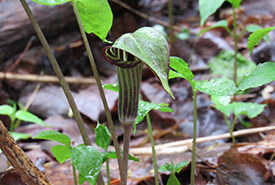
Jack-in-the-pulpit (Photo by Sherry Nigro)
Nearby nature can be surprising. I live in a suburb of Ottawa and have had foxes, salamanders, tree frogs, fire flies, bats and raccoons pass through the back yard. Plants like red trilliums, trout lilies, Jack-in-the-pulpit and meadow rue grow in a nearby woodlot, among trees like white pine, maple, birch, hawthorn and even old apple trees.
A healthy future
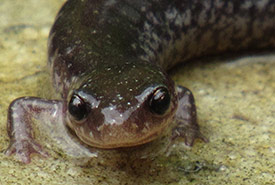
Eastern redbacked salamander, leadback phase (Photo by Sherry Nigro)
Connecting our children to the natural world is one of the most important things we can do. And in doing so, we contribute to the collective good for the future. Children who spend time in nature develop pro-environmental attitudes and are more likely to become responsible stewards of the Earth7. We need the next generation to have a passion for the environment, to create sustainable solutions to the pressing issues of climate change and loss of biodiversity, and to seek a harmonious co-existence with the natural world.
So, whether the children in your life are family, students, tenants, patients or constituents, do your part to create a healthier, happier future this Earth Day: encourage and support a connection to nature. Remember: buddies, boundaries and nearby nature, and let them play in the dirt, splash in puddles, chase butterflies, catch and release tadpoles, make dandelion chains and climb trees.
Our future, their future, depends on it.
Resources:
1. Toronto Public Health. 2015. Green City: Why Nature Matters to Health. Downloaded from https://www.toronto.ca/legdocs/mmis/2015/hl/bgrd/backgroundfile-83420.pdf
2. ParticipACTION. 2015. 2015 Report Card-The Biggest Risk is Keeping Kids Indoors. Downloaded from https://www.participaction.com/sites/default/files/downloads/Participaction-2015ReportCard-FullReport_2.pdf
3. American Public Health Association. 2013. Improving Health and Wellness through Access to Nature. Downloaded from https://www.apha.org/policies-and-advocacy/public-health-policy-statements/policy-database/2014/07/08/09/18/improving-health-and-wellness-through-access-to-nature
4. Capaldi, C., Dopka, Raelyne, Zelenski, John. 2014. The relationship between nature connectedness and happiness: a meta analysis. Frontiers in Psychology, Vol. 5, Article 976. Downloaded from https://www.frontiersin.org/articles/10.3389/fpsyg.2014.00976/full
5. ParticipACTION. 2015. 2015 Report Card-The Biggest Risk is Keeping Kids Indoors. Downloaded from https://www.participaction.com/sites/default/files/downloads/Participaction-2015ReportCard-FullReport_2.pdf
6. ParticipACTION. 2016. The 2016 Report Card on Physical Activity for Children and Youth- Are Canadian Kids Too Tired to Move. Downloaded from https://www.participaction.com/sites/default/files/downloads/2016%20ParticipACTION%20Report%20Card%20-%20Full%20Report.pdf
7. Wells, Nancy, Lekies, Kristi. 2006. Nature and the Life Course: Pathways from Childhood Nature Experiences to Adult Environmentalism. Downloaded from https://www.researchgate.net/profile/Nancy_Wells2/publication/252512760_Nature_and_the_Life_Course_Pathways_from_Childhood_Nature_Experiences_to_Adult_Environmentalism1/links/53e180f30cf2d79877a9c9fd.pdf

